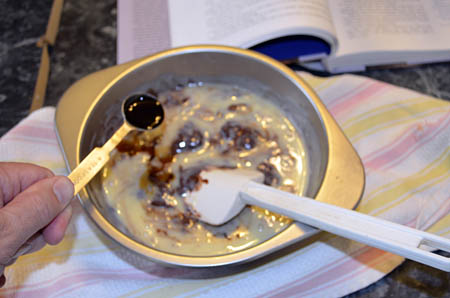Corn Melba
Source: Maida Heatter's Cookies (Andrews & McMeel Publishing, 1997 ed.), pg. 284.
I approached this recipe with a lot of trepidation and uncertainty. The thought of making homemade crackers seemed difficult and I was so afraid I would make a mess of it. Michael makes a really great chicken noodle soup and he had mentioned finding some unique crackers to serve with it. I happened to remember seeing this recipe in Maida's book, so I looked it up. In the end, it turned out great and the crackers were a huge hit. They vanished in no time and the raves made it all worth while!
These crackers are super thin and crisp. The recipe is hard to describe but it isn't really that difficult. It requires constant attention to the oven because the crackers bake at different time periods and you have to keep removing the pan in and out of the oven to take the crackers that are ready off the pan. I found that the crackers on the outer edge of the pan browned first and it was impossible to get all the crackers to bake evenly. That is okay - she says that you will have both dark and light crackers. Even so, they are delicious whether they are browned or just slightly browned. I have an Air-flow baking pan that I will try the next time I make these and see if that helps.
Maida Heatter discovered these crackers at the Hampshire House in New York City. They were served as appetizers in baskets in the hotel dining room. The hotel would not give her the recipe and she searched for it for years. She finally located it in a pamphlet that had been published by Vogue magazine that featured recipes from famous hostesses in New York.
Cayenne pepper can be added for an extra kick (I didn't try this). Just add 1/4 teaspoon of cayenne to 2/3 cup of the batter for one each pan.
Most of the ingredients should be at room temperature so set them out ahead of time.
2 cups double or triple sifted all-purpose flour
2 tsp. baking powder
1/2 tsp. salt
4 oz. (1 stick) unsalted butter, room temperature
2 TBS. granulated sugar
2 eggs
1 cup milk, at room temperature
1 cup water, at room temperature
1/2 cup cornmeal (white or yellow)
These are made in jelly-roll pans that measure 10.5 x 15.5. They are cut in the pan so do not use pans with a non-stick finish. The more pans you have, the better and it won't take as much time.
Preheat the oven to 375. Butter the pans lightly.
 |
| Sift together the flour, baking powder and salt. Set aside. |
 |
| Beat the butter until it is soft. |
 |
| Beat in the sugar. |
 |
| Add the eggs, one at a time. |
 |
| On low speed, add the flour mixture in 3 additions, alternating with the milk and water. |
 |
| Add the cornmeal last and beat only until mixed. |
 |
| Strain the batter to remove any lumps. |
 |
| You will have about 4 cups of batter that will make 6 pans of crackers. Use 2/3 cup of batter per pan. Pour the batter along one side of the pan. |
 |
| Now you will need to hold up the pans and rotate them to allow the mixture to coat the entire pan evenly. This may take a while - just keep turning the pans and letting the mixture run down until you have an even coating. You can add a little more batter if it simply won't coat the entire pan. |
 |
| Ready for baking! |
 |
| Bake for about 5-7 minutes, then remove the pan and score the batter with a sharp knife. Cut the long way to make 4 strips, then cut crossways to make 16 rectangles. |
 |
| Return the pan to the oven and bake for an additional 10-25 minutes. You will have to keep an eye on the pan. Reverse the pans for even baking. Some of the crackers will be darker in color and others will be lighter. The crackers will not be done at the same time. You can tell when they are done - they should be lightly browned or firm. Remove them from the oven as they are done. |
 |
| Use a wide metal spatula to transfer to a paper towel to cool. |
Wash, dry and re-butter the pans each time you use them. They are very fragile so handle with care. Store in an airtight container and they will stay crisp. They can also be frozen.




























































